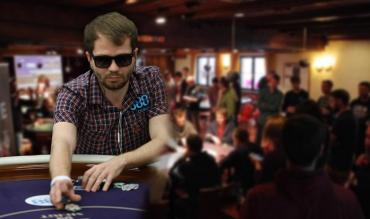The term “3 bet” has a tendency to cause confusion, especially amongst newer players. It frequently happens that a new player will assume that a “3 bet” is a raise roughly 3 times the size of the previous bet. It’s quite easy to see how this assumption arises. Let’s first consider the correct definition of “3 bet”.
3 bet = The third bet in any given sequence of bets.
Watch Kara Scott Interview with Martin Jacobson on 3 betting:
The reason for the confusion is that when we 3 bet preflop it appears to actually be only the second bet in the sequence. A player open-raises, we decide to re-raise them. The reason why this is referred to as a 3 bet is because the mandatory SB and BB payments are referred to as the first bet in the sequence. Hence the open-raise is actually a “2bet”, while the re-raise is considered a 3 bet.
Because of this, confusion arises now regarding postflop 3 bets. Imagine our opponent fires a continuation bet on the flop and we check-raise. This is now clearly the 2nd bet in the sequence, but it gets commonly (yet mistakenly) referred to as a “3 bet” by many players. In order for an actual 3 bet to take place, our opponent must re-raise again over our check/raise in the given example.
Why 3 betting is Important
It doesn’t take a huge amount of statistical analysis to realise that 3 betting makes more money than cold-calling on average. The only reason we don’t 3 bet our entire continuing range preflop is that our opponents might adjust and begin to exploit us, when they realise we are 3 betting too aggressively. The idea is to get away with 3 betting as much as possible without our opponents being able to make exploitative adjustments.
To put it simply, we need to incorporate 3 betting into our poker strategy because it can provide a significant boost to our winrate.
Let’s take a look at some potential 3 betting ranges against opens from various positions.
3 betting on the Button
The button is a great place to 3 bet aggressively since, if we get called, we are always guaranteed to have position postflop.
Our 3 betting range will typically be divided into a selection of value-hands and a selection of bluffs. In most cases, it is correct to bluff slightly more than we value-3 bet. The effect of position on this should be noticeable – we can get away with a higher ratio of bluffs, assuming we have position.
The purpose of a value 3-bet is simply to get called by a decent selection of worse hands in order to make money. The purpose of a bluff 3 bet is to take the pot down preflop. We know that we usually do not have the best hand, but if our opponent sometimes folds, we can profit.
Usually, we don’t bluff with any 2 cards.We pick hands that have potential to improve to a strong 5-card holding by the river. These hands will frequently have a nice combination of both playability and poker equity, maybe something like Axs for example.
We’ll often find that it is common for our 3 bet bluffing hands to be slightly weaker than our cold-calling hands, although this is not always true.
3 bet BTN vs CO
In the following chart, our value-3bets are represented in light red while our bluff-3bets are represented in dark red.
Value 3bet range – 4.52%
Bluff 3bet range – 9.05%
Total 3bet range – 13.57%
Notice how there is a gap between the bluff 3 bets and value 3 bets. For example, holdings such as ATs. These holdings usually end up in our flatting range and are a little too strong for us to consider 3 bet bluffing.
BTN vs MP
Notice that our 3 betting range is significantly tighter when facing an MP open. It’s also important to notice the types of hands that we are using to bluff.
We don’t have a lot of speculative hands like suited-connectors; we are primarily bluffing with a range that has good equity. The reason for this is that we are more likely to get to showdown when we have position, and our raw-equity is a little bit more important.
If we compare these ranges to the OOP ranges, we will notice that speculative hands are the ones that primarily constitute the bluffing range. With those types of hands, playability is more important out-of-position, while equity is less important.
Value 3bet range – 1.66%
Bluff 3bet range – 3.32%
Total 3bet range – 4.98%
BTN vs UTG
Naturally this will be tighter than the previous two ranges since now we are facing a raise from UTG, which is typically strong.
Value 3bet range – 0.9%
Bluff 3bet range – 2.11%
Total 3bet range – 3.01%
CO vs MP
We will notice here that the numbers are the same as BTN vs MP, but the ranges are a little different.
This is to do with which hands we can profitably cold-call. We can actually cold-call a slightly wider range from the BTN since we only have 2 players left to act behind us who may squeeze. Cold-calling in the CO is a little bit less profitable, so we will be more inclined to use certain types of hands to 3 bet ourselves.
For this reason we will see that, despite having the same frequency as BTN vs MP, the CO vs MP 3 betting range is slightly stronger.
Value 3bet range – 1.66
Bluff 3bet range – 3.32%
Total 3bet range – 4.98%
CO vs UTG
Even vs UTG opens we should still have a 3 bet bluffing range. Some players never do this, and they are missing out on profitable situations as a result.
Our 3 bet bluffing range vs an EP (early position) open will typically be a lot stronger than our 3 bet bluffing range vs an LP (late position) open, however.
Value 3bet range 0.9
Bluff 3bet range 1.81%
Total 3bet range 2.71%
MP vs UTG
Here we are playing against UTG and also still have 4 players to act behind us. It should make sense to play a very tight range here.
3bet Value range – 0.9%
3bet Bluff range – 1.51%
Total 3bet range – 24.1%
3 betting OOP
Let’s have a look now at some 3 betting ranges, which we can use OOP from the blinds.
There are 2 main differences here regarding the distribution of value and bluff hands.
- The bluffing range is more “polarized”. We will see that the bluffing hands are now speculative hands as opposed to high-equity hands.
- There are fewer bluffs in our range for each value hand. This is primarily to do with being OOP - meaning it’s harder to get away with many bluffs. But it also has to do with the fact that our bluffs have less equity (given they are speculative) - meaning it’s generally correct to bluff a little less overall.
BB vs BTN
Notice that this range is designed for facing a 2.5bb open, whereas the previous ranges have been designed for facing a 3bb open. It’s common for players to reduce their sizing slightly when opening on the button in todays games, so 2.5bb is generally a more realistic example.
Value 3bet range – 4.52%
Bluff 3bet range – 5.43%
Total 3bet range – 9.95%
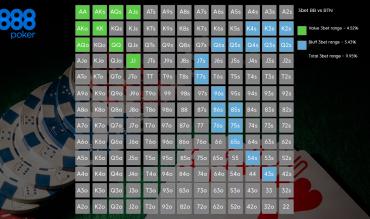
BB vs CO
Notice that a higher degree of polarization now occurrs in our 3 betting strategy. We can see a clear separation between our value-range and our bluffing range, which now consists of low-equity speculative holdings.
Value 3bet Range – 3.77%
Bluff 3bet Range – 4.22%
Total 3bet Range – 7.99%
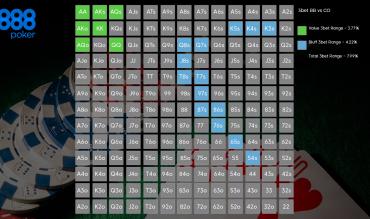
BB vs MP
The value range OOP vs EP/MP will be extremely tight. In the majority of cases it is recommended to only value 3 bet AA/KK (0.9%) assuming 100bb effective stacks.
Value 3bet Range – 0.90%
Bluff 3bet Range – 1.81%
Total 3bet Range – 2.71%
BB vs UTG
Value 3bet range – 0.9%
Bluff 3bet range – 1.51%
Total 3bet range – 2.41%
SB vs BTN
Value 3bet Range – 4.52%
Bluff 3bet range – 6.79%
Total 3bet range – 11.31%
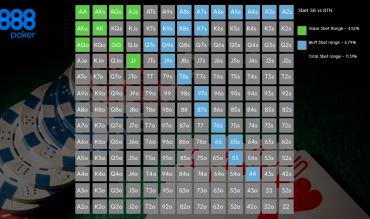
SB vs CO
Value 3bet Range – 3.77%
Bluff 3bet Range – 5.58%
Overall 3bet Range – 9.35%
SB vs MP
Value 3bet range – 0.90%
Bluff 3bet range – 1.51%
Total 3bet range – 2.41%
SB vs UTG
Value 3bet range – 0.90%
Bluff 3bet range – 1.21%
Total 3bet range – 2.11%
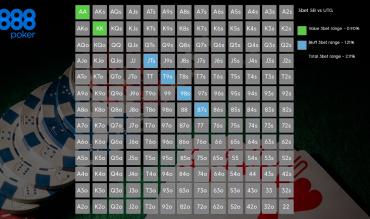
BB vs SB
There is one additional range that is extremely important which is BB vs SB. This is a very powerful situation in No-Limit Hold’em. SB often opens quite wide in today’s games, and we are guaranteed position postflop assuming our 3 bet gets called. We also don’t need to worry about a player behind us squeezing, forcing us to fold our bluffs, since we are last to act.
Notice how wide the 3 bet bluff range is. This is partly to do with us being able to cold-call so wide in a BB vs SB situation. (We often choose our bluffs as slightly weaker hands than our cold-calling hands). On average we should be defending around 50% of hands from the BB against a 2.5bb SB open, 35% by cold-calling and 15% by 3 betting.
Value 3bet range – 6.18%
Bluff 3bet range – 9.65%
Total 3bet range – 15.83%
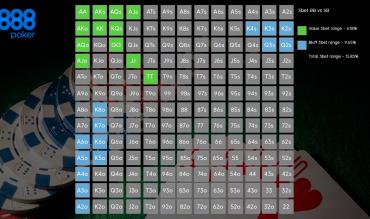
Putting it Together
So a few important notes on the ranges.
Firstly it should be possible to 3 bet even wider than is outlined vs many opponents. One of the reasons for this is that at lower-limit games most players are not 4betting as aggressively as they should be. As a result we can get away with 3 betting wider than is theoretically correct.
Another thing to keep in mind is that our 3 betting ranges will vary depending on the size of the open-raise. So we have looked at 3 etting ranges facing 2.5x and 3x opens, but we need to also have a gameplan for playing against 2x and 4x opens, and pretty much any other sizing we regularly face.
The ranges we have considered are simply default ranges against unknown opponents. As we pick up more information, we will usually consider adjusting our strategy as an exploitative measure.
Let’s say we have an opponent who never folds to 3 bets. We will typically cut back on our 3-bet bluffing hands but consider going a little wider with our value-3bets. And what if our opponent folds way too much to 3 bets? We consider reversing our strategy; 3 bet bluffing a ton, and potentially even slowplaying some of our stronger holdings preflop as opposed to value 3 betting.
